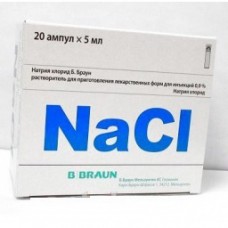Expiration date: 04/2026
Packaging
Container 5, 250 or 500 ml
10 or 20 PCs
Pharmacological action
Ions of sodium and chlorine - the most important inorganic components of extracellular liquid. They maintain osmotic pressure of blood plasma and extracellular fluid. In the dehydration isotonic solution fills a deficit of body fluids. Hypertonic solution of sodium chloride with the use of/provides a correction of osmotic pressure of extracellular fluid and blood plasma. As sodium chloride is used in ophthalmology - when the local application has anti-edema effect.
Testimony
- Isotonic solution: the dehydration of various origins. To maintain the volume of blood plasma during and after surgery. As a solvent for various drugs.
- Hypertonic solution: disorders of water and electrolyte metabolism: deficiency of sodium and chlorine ions, Hypo dehydration of various origins (due to prolonged vomiting, diarrhoea, burns, gastric fistula, pulmonary hemorrhage, intestinal bleeding).
Contraindications
- Hypernatremia.
- Acidosis.
- Giperhloremia.
- Hypokalemia.
- Extracellular gipergidratace.
- Circulatory disorders, threatening swelling of the brain and lungs.
- Swelling of the brain.
- Pulmonary edema.
- Acute left ventricular failure.
- Concomitant appointment of glucocorticoids in large doses.
With caution:
- Decompensated chronic heart failure .
- Hypertension.
- Peripheral edema.
- Preeclampsia.
- Chronic renal failure:
- Oliguria.
- Anuria.
- Aldosteronism and other conditions associated with sodium retention in the body.
Application for violations of renal function
With careful use of large amounts of sodium chloride in patients with violation excretory function of the kidneys.
Application of pregnancy and breastfeeding
The solution can be administered during pregnancy and lactation.
Special instructions
With careful use of large amounts of sodium chloride in patients with violation excretory function of the kidneys, with hypokalemia. The introduction of large amounts of the solution can result in chloride acidosis, hyperhydration, increase of potassium deduction from the organism.
Hypertonic saline is not used, p/and/m.
With prolonged use requires monitoring of electrolytes in the plasma and daily urine output.
The temperature of the intravenous solution should be 38°C.
Method of application and doses
Isotonic solution of sodium chloride is injected into/in, n/a, and enemas and is also used for washing wounds, eyes, mucous nasal cavity. Often administered in/in, depending on the clinical situation - up to 3 l/day.
Hypertonic sodium chloride solution injected I/V. the dose for the on/in the introduction of the jet can reach 10-30 ml. for conditions requiring immediate replenishment of sodium and chlorine ions, the drug is injected in/in the drip in a dose of 100 ml.
Side effects
Possible: nausea, vomiting, diarrhea, stomach cramps, thirst, lacrimation, sweating, fever, tachycardia, arterial hypertension, impaired renal function, edema, shortness of breath, increased blood pressure, headache, dizziness, anxiety, weakness, twitching and muscle hypertonicity.
Drug interactions
Working with colloidal hemodynamic blood substitutes (mutual strengthening effect).
When mixed with other drugs it is necessary to visually control the work (however invisible and possible therapeutic incompatibilities).



